Brachialis muscle
What is the Brachialis muscle?
The Teichmann muscle is also known as the brachialis (brachialis antics). At the elbow joint, the brachialis muscle is a primary flexor of the elbow. It has a fusiform structure and is situated proximal to the biceps brachii in the anterior (flexor) compartment of the arm. The brachialis is a wide muscle, with its broadest portion in the center rather than at either end.
It is sometimes split into two sections and may fuse with biceps brachii, coracobrachialis, or pronator teres fibers. It also serves as part of the bottom of the cubital fossa.
The brachialis muscle is located in the upper arm, between the biceps and triceps muscles. It helps flex the elbow joint and is commonly used during lifting and pulling activities.
History
Etymology
The brachialis muscle is located in the upper arm’s muscle. In classical Latin brachialis implies of or about the arm, and is derived from classical Latin brachium means arm. In the present formal anatomic Domenico, the term musculus brachialis is used. Terminology of Anatomy
Origin of Brachialis muscle
The brachialis arises from the anterior side of the distal half of the humerus, near the deltoid muscle insertion, which it surrounds with two angular processes. Its origin stretches below to within 2.5 centimeters of the humerus’ articular surface at the elbow joint.
Insertion
Its fibers combine to form a thick tendon that is implanted into the ulnar tuberosity and the rough depression on the proximal side of the ulnar coronoid process.
Innervation
The musculocutaneous nerve innervates the brachialis muscle, which travels on its external surface between it and the biceps brachii. However, the muscle has double stimulation with the radial nerve in 70-80% of individuals. (C5-T1). The deltoid insertion marks the boundary between the two innervations.
Blood supply
The brachialis is supplied by branches of the brachial artery and the radial recurrent artery, with assistance from auxiliary vessels. Branching from the superior and inferior ulnar collateral arteries can occasionally add to the arterial nutrition of the brachialis muscle.
The accessory arteries are tiny and varied in size. They can develop straight from the brachial artery, the profunda brachii, or the superior and inferior ulnar collateral vessels. Venae comitantes empty the brachialis, mimicking the arterial flow and eventually draining back into the brachial veins.
Relations
The brachialis is located on the anterior side of the humeral shaft, deep to the biceps brachii muscle belly and distally to its tendon. The biceps brachii muscle, as well as the brachial vessels, and musculocutaneous and median nerves, are situated directly adjacent to the brachialis. The humerus and elbow capsule are located back to the muscle.
The midline intermuscular septum and pronator teres divide the brachialis from the triceps brachii and the ulnar nerve. Laterally, it is connected to the radial nerve, the brachioradialis, and the flexor carpi radialis longus muscles. The brachialis ligament is part of the cubital fossa’s bottom.
Variation
Additional muscle slippage to the supinator, pronator teres, biceps brachii, lacertus fibrosis, or radius is more uncommon.
Function of Brachialis muscle
The brachialis is regarded as the elbow’s muscle. It is a primary forearm flexor at the elbow joint, flexing the elbow in all orientations. The brachialis is the only true flexor of the elbow joint, and it generates the bulk of the power during elbow abduction. It is unaffected by forearm pronation or supination, and it does not engage in pronation or supination due to its absence of attachment to the radius.
The brachialis stabilizes the action by relaxing at a steady rate during regulated elbow flexion. This is an eccentric muscular movement. This action is used for precise motions such as delicately lowering a teacup onto a level surface. The brachialis also functions of maintaining the elbow flexed, so when the elbow joint is banded, the brachialis is always constricting.
Clinical relevance
Brachialis muscle pain
Pain in the brachialis muscle can be caused by a variety of factors, including overuse, muscle strain or sprain, or injury. Symptoms may include tenderness, stiffness, and aching in the affected area.
Treatment for brachialis muscle pain typically involves rest, ice, compression, and elevation (RICE). Over-the-counter pain relievers such as acetaminophen or nonsteroidal anti-inflammatory drugs (NSAIDs) may also be helpful in managing pain and reducing inflammation. Physical therapy exercises and stretching can help to strengthen the muscle and prevent future injury.
If the pain persists or becomes severe, it’s important to see a doctor or physical therapist for an evaluation. They may recommend additional treatment options, such as massage, ultrasound therapy, or corticosteroid injections, depending on the severity of the injury.
Brachialis injury
A brachialis injury can occur as a result of a sudden impact or trauma to the muscle, or as a result of overuse or repetitive strain. Symptoms of a brachialis injury can include pain, swelling, bruising, and weakness in the affected arm.
Treatment for a brachialis injury typically involves rest, ice, compression, and elevation (RICE) in the early stages. This can help to reduce pain and swelling and promote healing. Over-the-counter pain relievers such as acetaminophen or nonsteroidal anti-inflammatory drugs (NSAIDs) may also be helpful in managing pain and reducing inflammation.
In some cases, physical therapy exercises and stretching may be recommended to help strengthen the muscle and prevent future injury. If the injury is severe or does not improve with conservative treatment, more advanced treatment options may be necessary, such as corticosteroid injections or surgery.
It’s important to see a doctor or physical therapist if you suspect you have a brachialis injury, as they can assess the severity of the injury and provide appropriate treatment recommendations. They can also help to determine the underlying cause of the injury and provide guidance on how to prevent future injuries.
Repetitive forceful spasms or muscular twitches with the arm in hyperextension are frequent causes of brachialis muscle injury. Because of the pronation of the hand and the stretched starting posture, this is prevalent in climbers. Pull-ups, curls, and rope scaling are all examples of physical activities that can cause brachialis muscular discomfort. A brachialis tendon injury can also generate a person to seem to lack arm flexion due to painful end-range tendon stretching. Because of the position of the discomfort, medial and lateral epicondylitis should be considered.
The brachialis serves as the cubital fossa’s bottom and is a component of the radial tube. It could be involved in Erb’s palsy if the Brachial plexus is damaged, resulting in forearm flexion paralysis.
Assessment
Place the elbow at 90 degrees of flexion with the forearm completely pronated to evaluate the brachialis muscle. The patient is then asked to withstand an inferior force applied to the distal wrist.
Stretching for brachialis muscle
Stretching with a Block
An easy stretch at the table with a block can extend the brachialis muscle. Place a solid item, such as a yoga block or a heavy book, in front of you as you sit at the table. Rest your elbow on the item and extend your wrist straight forwards. This should be done twice, once with the hand facing up and once with the palm facing down, to guarantee an even stretch.
Stretching on the Floor
Stretch the brachialis by laying on your back on the floor or in bed. Maintain a straight line with your legs in front of you and a solid grip on the floor with your arm. Using your other hand, push your forearm to the side while keeping your elbow connected to the pavement. Another floor exercise is to lie on your back and use your opposite hand to make a circle around your wrist and lift your arm over your head.
Stretching with the Table
A simple stretch at the table involves laying your arms on the table and turning your face upward with your opposite hand. Turn your hand up as far as it will go without burning, then turn it down in the same manner. Maintain a solid grip on the table with your forearm. You can also extend on the table by sitting in a chair and placing your wrist parallel to the table’s border. Lean forward with your feet anchored on the ground to begin the stretch.
Stretching with the Wall
The nerve system that runs from the neck to the hand is known as the plexus brachialis. Gentle nervous system stretching can relieve nerve compression produced by persistent conditions such as repetitive stress injury. (RSI). Stretch the plexus brachialis by standing arm’s length away from the wall and stretching the arm toward the wall. Keep the palm lower than the shoulder and the arm slightly in front of the torso. Place your palm, or fingertips, against the wall and slowly turn your head away from it.
Strengthening exercise for brachialis muscle
Unfortunately, this extremely strong elbow flexor is not as well-trained as the biceps. Because we are visual beings, we may place less emphasis on objects we cannot see, such as the brachialis. That would be a stupid thing to do because training the brachialis will provide a summary of important fitness factors. Here are the best advantages of brachialis exercise.
- Brachialis training will result in powerful biceps.
- A stronger brachialis will enhance efficiency.
- Strengthening the brachialis will result in larger arms.
- Injury can be reduced by strengthening the brachialis.
- Brachialis training will increase flexion power in the pronated posture.
Pull up
Pull-ups are an excellent compound exercise that strengthens the complete back. Often referred to as the “King of Bodyweight Movements,” including the pull-up in your training will result in massive muscular development and strength gains throughout your entire back. The pull-up, on the other hand, employs a pronated grip to lift your torso. Indeed, the pronation hold distinguishes it from the chin-up, which employs a supinated grip.
While both the pull-up and the chin-up are excellent exercises, the pull-up is the clear option for training your brachialis. Furthermore, because of the massive weight you are lifting, the pull-up is typically done slowly, particularly at the bottom of the action, which will result in greater activation of the brachialis.
Furthermore, the pull-up is extremely simple to set for increasing overload and even enables you to perform some hefty negatives, which we will go over in greater detail below.

EZ-Bar reverse curl
Curls with a supinated or underhand hold are almost always performed when people want to exercise their arms. In reality, the fact that a reverse curl is done with a pronated grip emphasizes this point. However, if they wanted to strengthen their forearm flexors, they would perform backward curls.
The reverse curl is done in the same way as a normal curl, but with a pronated grasp. Everything else is the same, including hand location, stance, and action.
Using the EZ bar, on the other hand, is much more comfortable for trainers and enables them to use heavier weights. This is because their handles are more neutral, putting less strain on the arms. At the same time, they are sufficiently pronated to attack the brachialis.
Place your wrists on the angled handle of an EZ-Bar. Keeping your arms in, flex your elbows to raise the weight to your torso. (again, same movement). One thing to keep in mind is that a trainee’s arms will tend to stretch out more during reverse curls. As a result, be cautious and keep your arms hidden.

Zottman curl
Zottman curls are performed with dumbbells and essentially require you to alternate between curling with a pronated and supinated grip. Traditionally, the movement begins with your hands at your sides in a neutral grip. For the concentric portion, you will then begin to curl the dumbbells upward. Rotating the dumbbells in this manner will place them in an underhand supinated position and allow you to progress up. After performing the eccentric with an overhand grip at the top, you will switch to a pronated grip.
Alternately, you can perform the same movement but switch it up; eccentric when using a supinated grip and concentric when using a pronated grip.
You can do this exercise standing up, lying down, or on a preacher stool like the one shown above.
Another feature of the Zottman curl that benefits brachialis training is that it is done slowly. As previously stated, slow-motion exercise can cause the brachialis to erupt.

Hammer curls with a rope attachment
The anvil hold. Although not quite pronated, it is still very efficient at striking the brachialis. As with the EZ-Bar, trainers are typically much stronger when using a neutral grip, so incorporating hammer curls into your exercise will enable you to use much greater loads. Furthermore, the biceps will continue to be largely omitted from the action. However, the brachioradialis will be more activated, which is not necessarily a negative thing. The brachioradialis is another overlooked forearm muscle that requires attention. A powerful brachioradialis helps to shift more weight with the brachialis.
We prefer to use the rope connection for hammer curls because the action appears to be smoother and more natural than when using a dumbbell. Furthermore, when using the wire, you can step back to change the orientation for a different stimulus. There’s nothing wrong with a tiny variation.
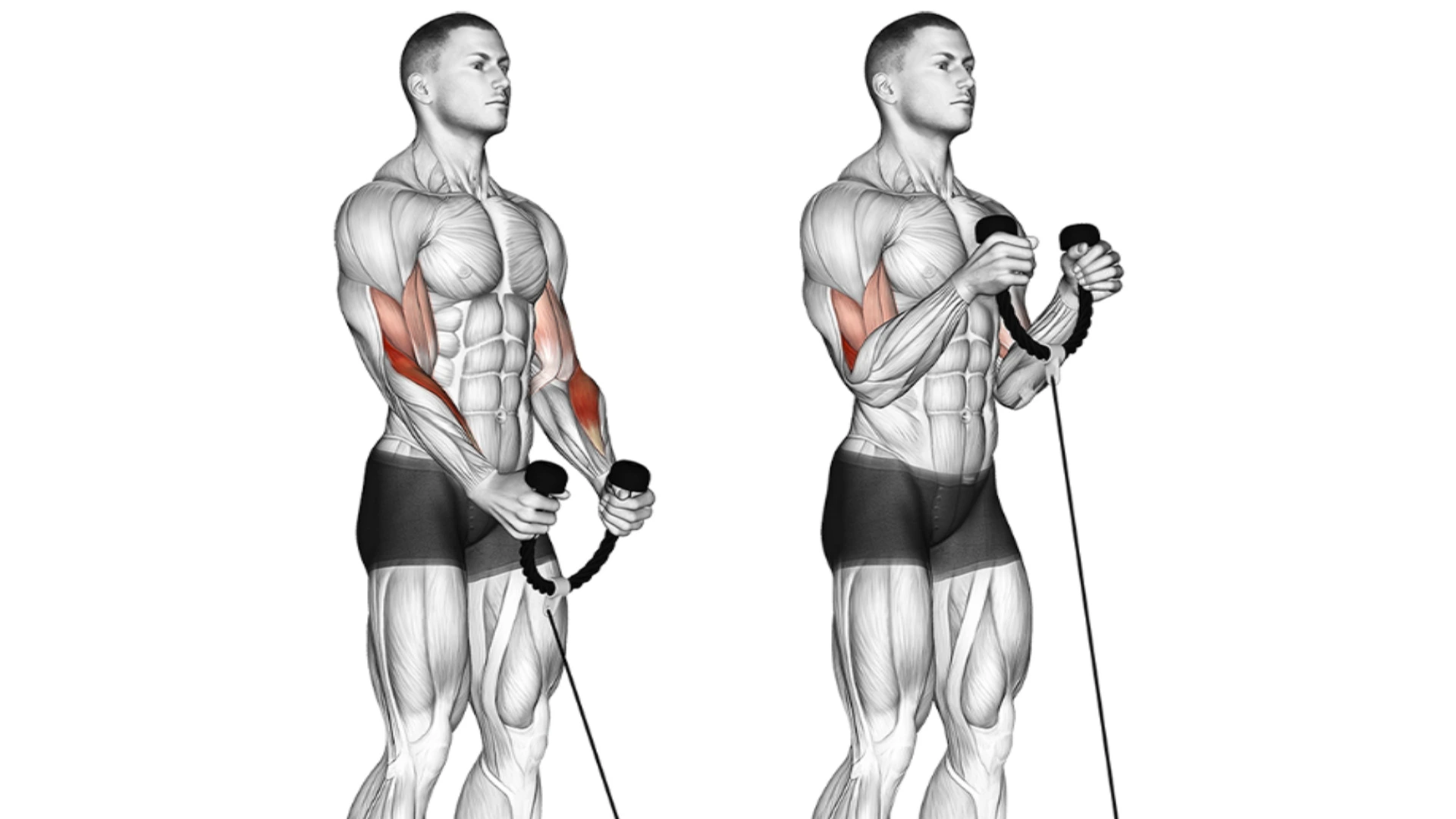
Cable reverse curl with a straight bar
We mentioned earlier that we like using the EZ-Bar for backward twists when using a barbell. As a result, when performing reverse curls, we suggest the reverse cable curl variant, which entails performing them on a cable pulley machine with a straight bar. (you can also use an EZ-Bar attachment).
When you use a cable, you can step back and change the position of the resistance. As a result, it appears to alleviate some of the problems associated with using a vertical dumbbell. However, with these, we suggest starting light and doing numerous repetitions.
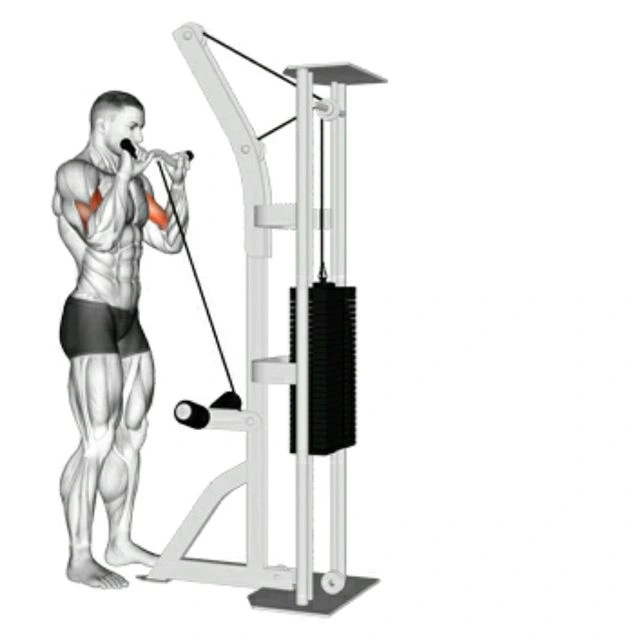
EZ-Bar preacher curl with a pronated grip
The preacher curl is a traditional bicep workout because it isolates the flexor muscles very well. To do the exercise, position your arms on a supportive cushion, which removes all bodily motion and allows your elbow flexors to do all of the work. As a result, the preacher curl is one of the most popular workouts for maximum muscular hypertrophy.
It makes sense to use this awesome exercise to train the brachialis because it is so excellent. Simply twist away while using a pronated hold. However, a word of caution: start light and avoid the hefty, slow eccentric technique described below. As previously stated, this action is extremely efficient, which implies severe muscle damage. Don’t overuse it at first.
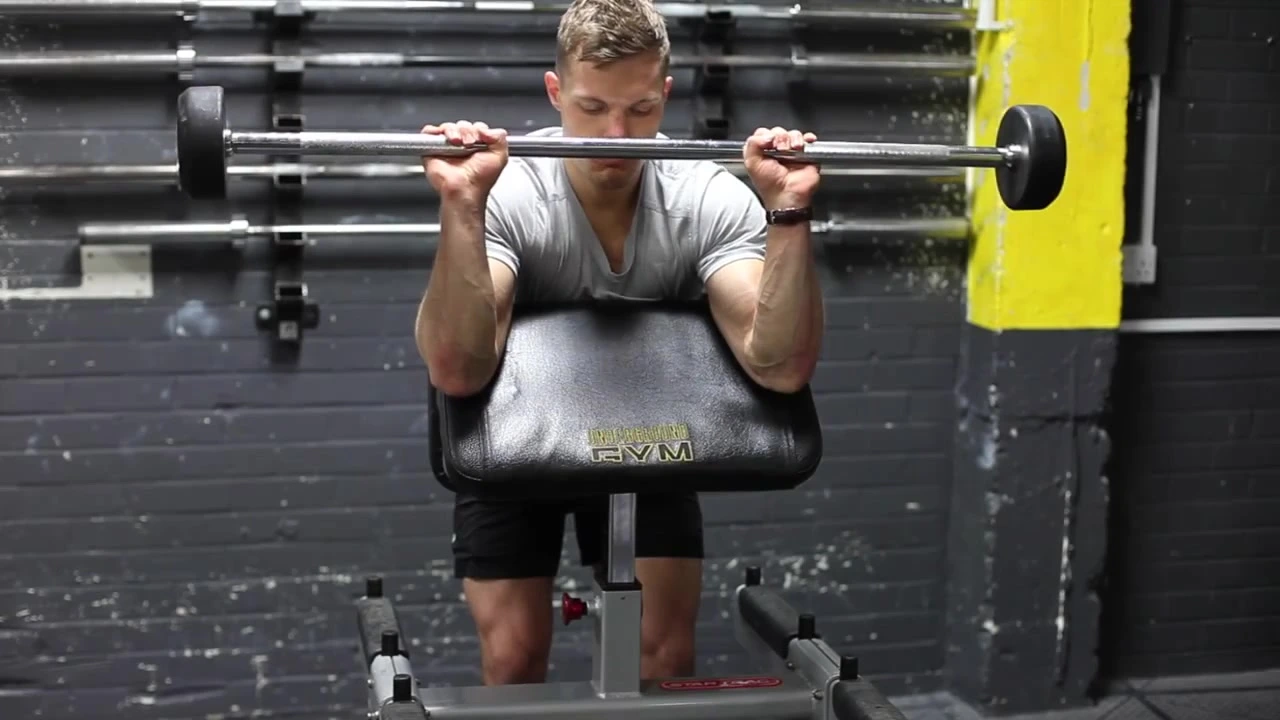
Cross-body dumbbell curl
The overhead dumbbell curl is an intriguing combination of a hammer curl and a supinated hold. Begin with your arms down by your sides, gripping a set of weights with a neutral grip. When you bring the weights up, you will bring them up at an inclination rather than straight up. With your hand facing your torso, run the dumbbell up your breast to the opposing shoulder. It’s a great variation on the dumbbell curl that not only targets the brachialis but also the biceps from a new position.
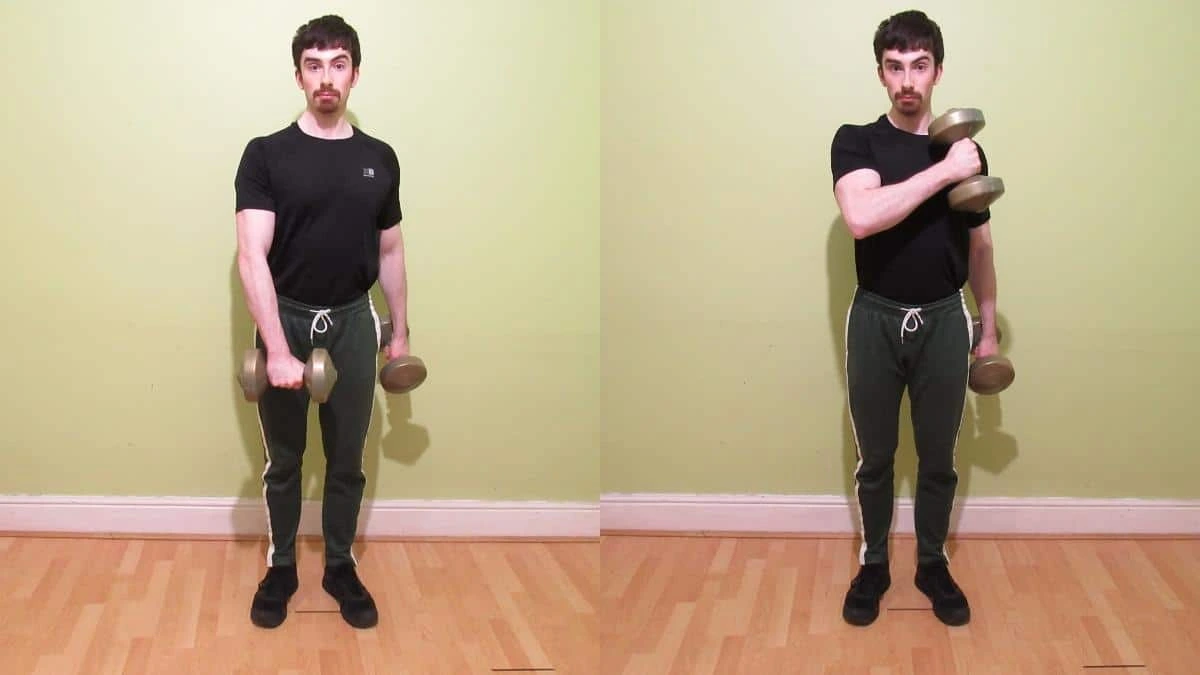
FAQ
Is the brachialis the bicep?
Where exactly is the brachialis muscle? The upper arm’s lower anterior compartment houses the brachialis muscle. It is at the inferior portion of the humerus bone, which runs from the shoulder to the elbow, and it is beneath the biceps brachii muscle.
Biceps or brachialis, which is stronger?
Function. The major flexor of the elbow is the brachialis. It has more strength than the coracobrachialis and biceps brachii due to its larger cross-sectional area.
Which arm muscle is the most difficult to exercise?
The triceps can be a very difficult body part to improve, even with training. Because it’s a place where fat tends to build up, working the muscle underneath the fat often doesn’t make much of a difference.
Which arm is typically more powerful?
Your dominant arm has the advantage of being stronger because you use it more frequently in day-to-day activities, regardless of whether you are right-handed or left-handed. Perhaps you always hold your toddler on one side of your body when you pick them up. Or maybe you always use your right arm to carry a heavy bag.
Does the brachialis make your arms bigger?
The Brachialis fills in as the principal elbow flexor and is situated under the Biceps Brachii. Building bigger arms and performing powerful pulling exercises like chin-ups and rows require working the brachialis muscles.

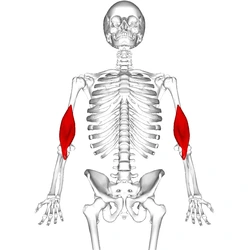
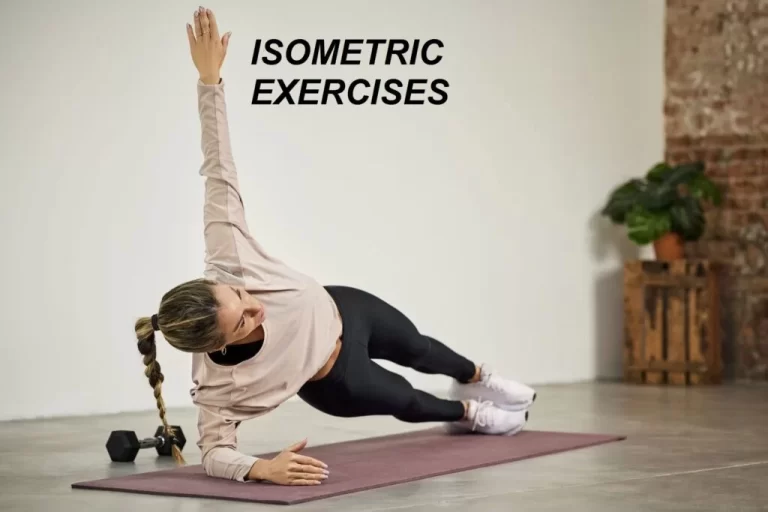




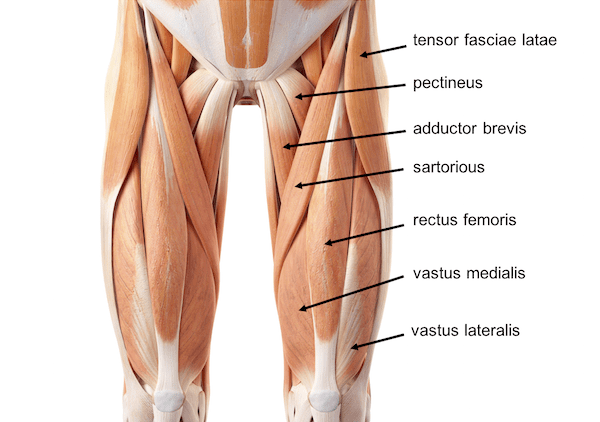
4 Comments